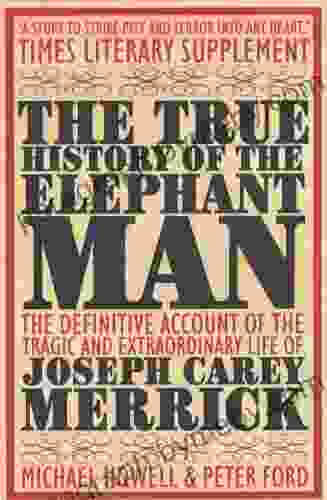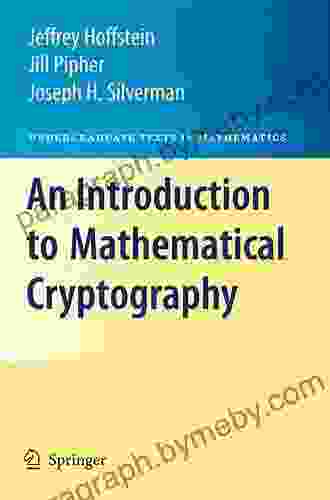Unlocking the Enigma: A Comprehensive Dive into Mathematical Cryptography

4.6 out of 5
| Language | : | English |
| File size | : | 15799 KB |
| Screen Reader | : | Supported |
| Print length | : | 524 pages |
In an era marked by rampant cyber threats and data breaches, cryptography has emerged as an indispensable tool for safeguarding sensitive information. At the heart of this intricate discipline lies mathematical cryptography, a fascinating field that seamlessly blends mathematical principles with sophisticated algorithms to provide unparalleled security. This article delves into the captivating world of mathematical cryptography, unravelling its rich history, indispensable applications, and cutting-edge advancements.
Mathematical Cryptography: A Historical Overview
The roots of mathematical cryptography can be traced back to ancient civilizations, where rudimentary forms of encryption were employed to protect secret messages. The development of more sophisticated techniques accelerated during the Renaissance, with the advent of polyalphabetic ciphers and the pioneering work of Leon Battista Alberti.
A major breakthrough occurred in the 19th century with the invention of the electric telegraph. As the volume of sensitive information transmitted over wires soared, the need for robust encryption methods became paramount. This period marked the genesis of modern cryptography, with the development of unbreakable ciphers like the Enigma machine used extensively during World War II.
Fundamental Concepts and Algorithms
Mathematical cryptography is anchored upon a bedrock of mathematical concepts and algorithms, including:
Number Theory
Number theory plays a pivotal role in cryptography, providing the foundation for algorithms like prime factorization and modular arithmetic. These concepts form the backbone of public-key cryptography, the cornerstone of secure communication over insecure channels.
Information Theory
Information theory quantifies the amount of information contained in a message and provides insights into the effectiveness of encryption algorithms. Concepts like entropy and information leakage are crucial for assessing the security of cryptographic systems.
Complexity Theory
Complexity theory delves into the computational complexity of cryptographic algorithms, categorizing them based on their difficulty to break. Algorithms that are computationally infeasible to break, even with the most powerful computers, are deemed secure.
Applications of Mathematical Cryptography
Mathematical cryptography finds wide-ranging applications in various sectors, including:
Data Security
Cryptography safeguards sensitive data stored on computers, mobile devices, and cloud servers. Encryption algorithms prevent unauthorized access, ensuring data confidentiality and integrity.
Secure Communication
Cryptography enables secure communication over insecure networks like the internet. Secure protocols like TLS (Transport Layer Security) and SSH (Secure Shell) utilize cryptography to protect emails, instant messages, and file transfers from eavesdropping.
Digital Signatures
Digital signatures allow individuals to verify the authenticity of digital documents and ensure non-repudiation. Cryptographic algorithms like RSA (Rivest-Shamir-Adleman) and DSA (Digital Signature Algorithm) empower users to digitally sign messages and documents, guaranteeing their integrity and origin.
Blockchain Technology
Blockchain technology, the backbone of cryptocurrencies like Bitcoin, relies heavily on cryptography for its security. Cryptographic algorithms ensure the immutability and integrity of blockchain transactions, preventing unauthorized modifications.
Latest Advancements in Mathematical Cryptography
The field of mathematical cryptography is constantly evolving, with ongoing research and advancements pushing the boundaries of security:
Quantum Cryptography
Quantum cryptography utilizes the principles of quantum mechanics to develop unbreakable encryption algorithms. Quantum computers, while still in their infancy, have the potential to revolutionize cryptography, rendering current encryption methods obsolete.
Homomorphic Encryption
Homomorphic encryption allows computations to be performed on encrypted data without decrypting it first. This breakthrough has opened up new possibilities for data analytics and secure cloud computing.
Lattice-Based Cryptography
Lattice-based cryptography leverages complex mathematical structures called lattices to construct encryption algorithms that are resistant to quantum attacks. These algorithms have emerged as promising candidates for post-quantum cryptography.
A Glimpse into 'An to Mathematical Cryptography'
For a comprehensive exploration of mathematical cryptography, 'An to Mathematical Cryptography' by Jeffrey Hoffstein, Jill Pipher, and Joseph Silverman offers an invaluable resource. This undergraduate-level textbook provides a thorough grounding in the field, covering:
* Number theory and its applications in cryptography* Information theory and its implications for secure communication* Complexity theory and its role in assessing cryptographic algorithms* Public-key cryptography and its importance in modern applications* Digital signatures and their use in ensuring authenticity and non-repudiation
'An to Mathematical Cryptography' serves as an indispensable guide for students, researchers, and practitioners seeking to master the intricate world of mathematical cryptography. Its clear explanations, comprehensive coverage, and insightful perspectives make it an essential resource for anyone interested in delving into this captivating field.
Mathematical cryptography stands as a cornerstone of modern information security, providing the tools and techniques to safeguard sensitive data in the digital age. Its foundations in number theory, information theory, and complexity theory empower us to develop sophisticated algorithms that protect our privacy, integrity, and authenticity in the face of evolving cyber threats.
'An to Mathematical Cryptography' offers a comprehensive and accessible to this fascinating field. Its in-depth coverage, real-world examples, and exploration of cutting-edge advancements make it an invaluable resource for anyone seeking to navigate the complexities of mathematical cryptography and unlock its potential.
As technology continues to advance and the volume of sensitive data grows exponentially, the importance of mathematical cryptography will only increase. By embracing this field, we empower ourselves to protect our digital lives and safeguard the future of information security.
4.6 out of 5
| Language | : | English |
| File size | : | 15799 KB |
| Screen Reader | : | Supported |
| Print length | : | 524 pages |
Do you want to contribute by writing guest posts on this blog?
Please contact us and send us a resume of previous articles that you have written.
 Book
Book Novel
Novel Page
Page Chapter
Chapter Text
Text Story
Story Genre
Genre Reader
Reader Library
Library Paperback
Paperback E-book
E-book Magazine
Magazine Newspaper
Newspaper Paragraph
Paragraph Sentence
Sentence Bookmark
Bookmark Shelf
Shelf Glossary
Glossary Bibliography
Bibliography Foreword
Foreword Preface
Preface Synopsis
Synopsis Annotation
Annotation Footnote
Footnote Manuscript
Manuscript Scroll
Scroll Codex
Codex Tome
Tome Bestseller
Bestseller Classics
Classics Library card
Library card Narrative
Narrative Biography
Biography Autobiography
Autobiography Memoir
Memoir Reference
Reference Encyclopedia
Encyclopedia Jim Acosta
Jim Acosta Jen Houcek
Jen Houcek Jean Rhodes
Jean Rhodes Sharon Stone
Sharon Stone Jessica Augustsson
Jessica Augustsson Jeff Henigson
Jeff Henigson Mahesh Daas
Mahesh Daas Jessica Fanigliulo
Jessica Fanigliulo Rusty Young
Rusty Young Jen Brister
Jen Brister Jennifer Cruz
Jennifer Cruz Patricia Spyer
Patricia Spyer Tania N Shah
Tania N Shah E C Segar
E C Segar Tchicaya Missamou
Tchicaya Missamou Mia King
Mia King Jennie Smallenbroek
Jennie Smallenbroek Jeannette De Wyze
Jeannette De Wyze Oren Klaff
Oren Klaff Jennifer Lapidus
Jennifer Lapidus
Light bulbAdvertise smarter! Our strategic ad space ensures maximum exposure. Reserve your spot today!

 Clarence BrooksEscape into the Lost Lands: An Epic Fantasy Adventure That Will Transport You...
Clarence BrooksEscape into the Lost Lands: An Epic Fantasy Adventure That Will Transport You... David MitchellFollow ·5k
David MitchellFollow ·5k Jon ReedFollow ·4.9k
Jon ReedFollow ·4.9k Felix HayesFollow ·10.3k
Felix HayesFollow ·10.3k Eugene PowellFollow ·7.9k
Eugene PowellFollow ·7.9k Heath PowellFollow ·18.4k
Heath PowellFollow ·18.4k Roald DahlFollow ·18.1k
Roald DahlFollow ·18.1k Theodore MitchellFollow ·10.3k
Theodore MitchellFollow ·10.3k Dale MitchellFollow ·12k
Dale MitchellFollow ·12k

 Jeremy Mitchell
Jeremy MitchellUnveiling the Truth: The Captivating Saga of The Elephant...
Embark on a poignant journey through the...

 Marvin Hayes
Marvin HayesThe Day The World Came To Town: A Heartwarming Tale of a...
In the quaint...

 Hugh Bell
Hugh BellExplore the Avian Treasures of Wisconsin: A Review of...
Unveiling the Secrets of...
4.6 out of 5
| Language | : | English |
| File size | : | 15799 KB |
| Screen Reader | : | Supported |
| Print length | : | 524 pages |















